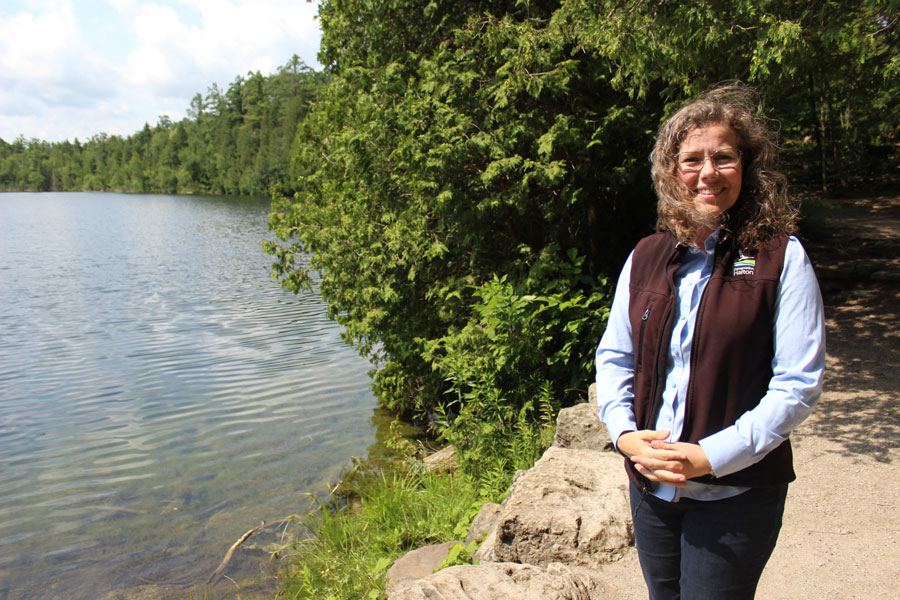MILTON – Layers of 70-year-old sediment at the bottom of Crawford Lake paint a picture of humanity’s impact on Earth.
Located less than 10 kilometres east of Puslinch, the deep little lake holds evidence of agriculture, fossil fuels and nuclear bombs.
The lake is so small it’d be considered a pond if not for its depth. At 24 metres it’s about as deep as an eight storey building is tall.
Crawford received global attention last week, when the Anthropocene Working Group, an international panel of geologists, announced the lake contains the best evidence on Earth to support the theory that a new epoch – a new geological chapter in the history of the world – is upon us.
Known as the Anthropocene, or the age of the people, the new epoch is defined by our impact upon Earth.
The lake may hold the key to settling a decades-old debate among geologists about the dawn of this new age.
Scientists leading the research at Crawford Lake are professors Francine McCarthy and Martin Head from Brock University, and Tim Patterson from Carleton University.
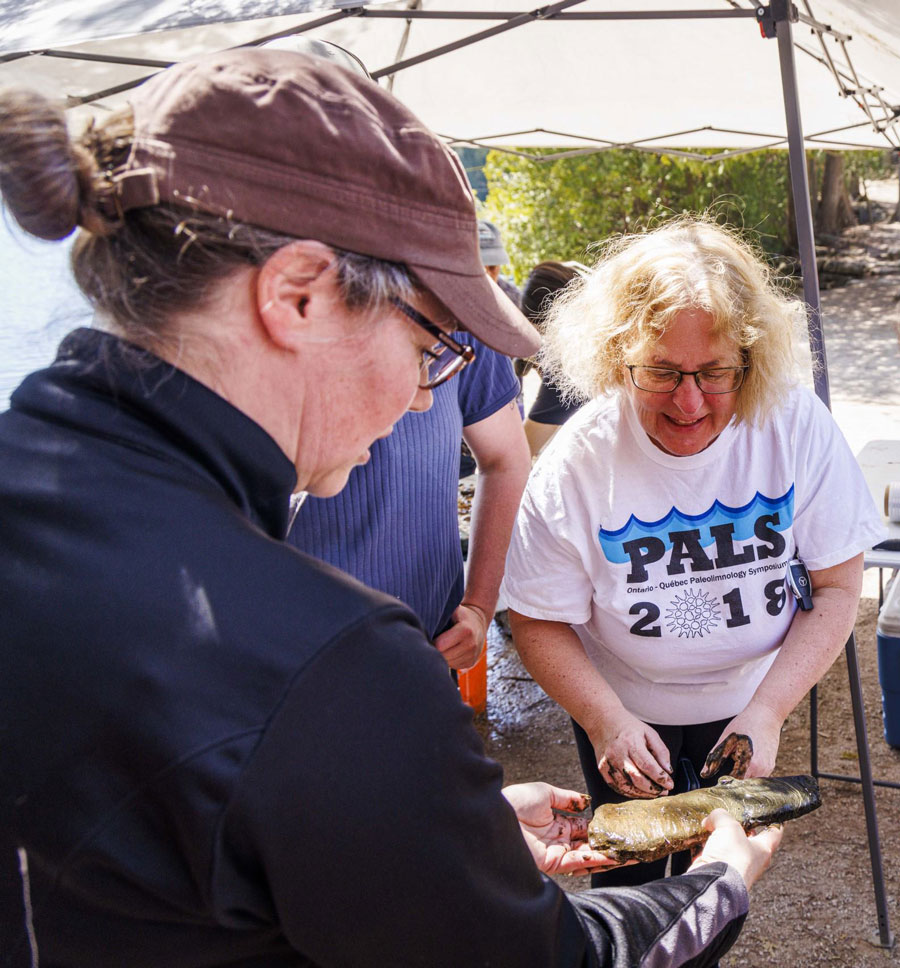
A closer look – Brock University Professor of Earth Sciences Francine McCarthy, right, inspects a sample of sediment layers held by Conservation Halton education manager Brenna Bartley. Submitted photo.
Stories in the sediment
Sediment beneath the serene water lies in alternating light and dark layers, corresponding with summer and winter seasons.
Like tree trunk rings, the layers offer a glimpse into the passage of time.
The lake is over 10,000 years old, but layers first formed about 1,000 years ago, beginning when Wendat and Attawandaron people were farming nearby.
In 1971, corn pollen was found in the layers that dated back 600 to 1,000 years, showing agriculture had been practiced in the area and leading to the discovery of a Wendat and Attawandaron settlement.
Archeologists searched for evidence of a settlement and found evidence of 11 longhouses. There are now three reconstructed longhouses that attract visitors from around the world.
The longhouses also offer a gathering place for Indigenous people, including Wyandot FaithKeeper, Elder, and artist Catherine Tàmmaro, for whom Crawford Lake is an ancestral site.
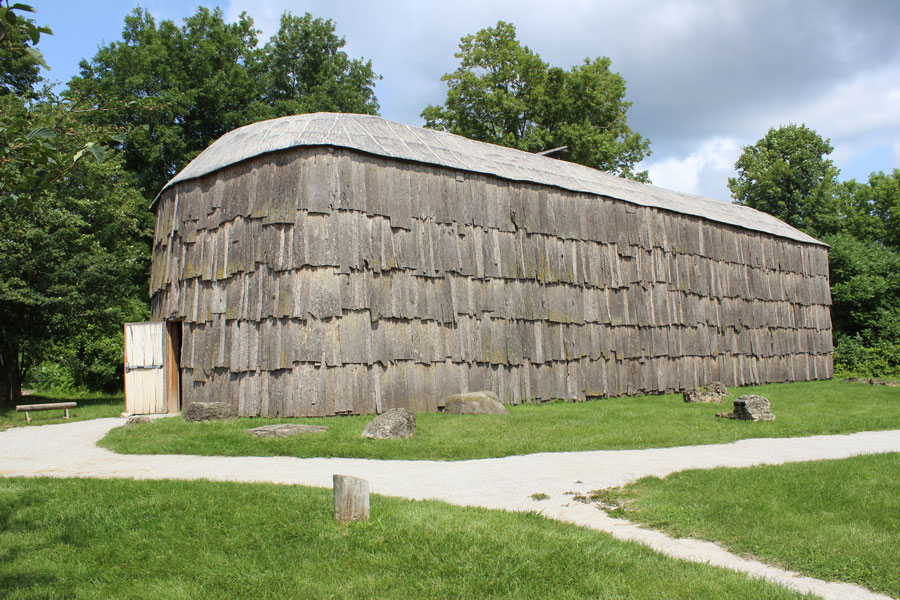
Longhouse – The sediment layers under Crawford Lake also led to the discovery of traces of 11 Wendat and Attawandaron longhouses nearby. This is one of three reconstructed longhouses built on the original footprints. Photo by Robin George
Preservation conditions
The sediment holds such detailed documentation of time because of Crawford Lake’s specific conditions.
It is a meromictic lake with two levels of water that never mix.
The lower level of most meromictic lakes has minimal oxygen, but the bottom of Crawford Lake is teeming with oxygen molecules, making the lake even more unusual.
The upper-most level of water is “full of life,” said Conservation Halton education and research manager Brenna Bartley.
Sitting beside the lake, Bartley spoke enthusiastically of snapping turtles, smallmouth bass, pumpkinseed sunfish and catfish all living in that top level.
When tourists paused beside her, she warmly welcomed them and explained the scientific implications of the sediment beneath it with excitement.
Crawford Lake is preserved by Conservation Halton and Indigenous stewards. People are not permitted to fish, swim or boat in the lake, outside of rare exceptions such as sample collections, Bartley said.
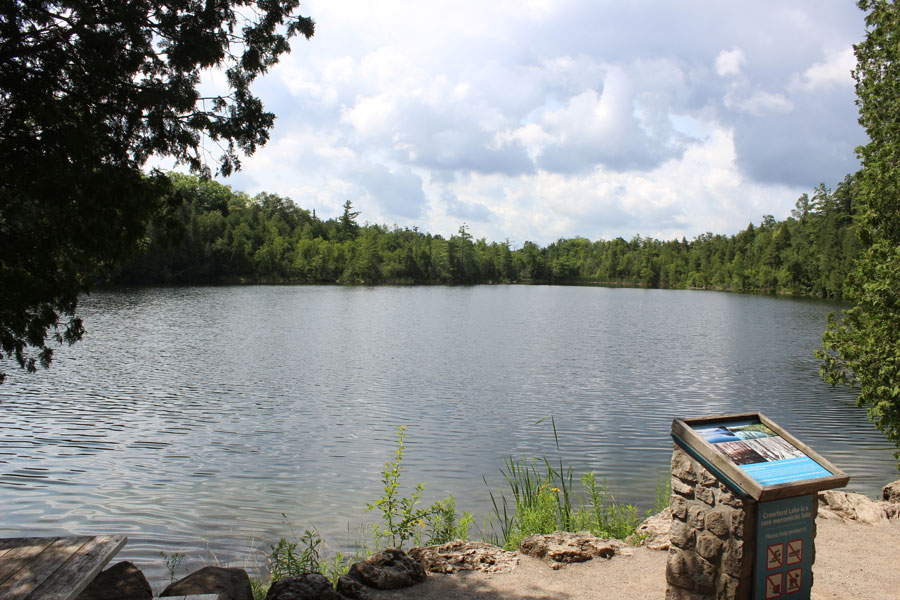
Evidence of the Anthropocene – Crawford Lake, located 10 kilometres east of Puslinch, has been chosen as the place with the best evidence in the world to support the theory that the Earth has entered a new geological chapter, or epoch, called the Anthropocene. The Anthropocene, or age of the people, is defined by humanity’s impact on the planet. Photo by Robin George
The Great Acceleration
In addition to stories of local Indigenous agriculture centuries ago, the sediment under the lake depicts evidence of the Great Acceleration, a period of rapid growth of energy use and greenhouse gas emissions from the 1950s onwards.
It’s evidence of the Great Acceleration that implies a new epoch.
Sediment under Crawford Lake has traces of plutonium from large-scale testing of nuclear bombs and fly ash particles from fossil fuels dating back seven decades.
Sediments, ice records and coral reef rings show this plutonium and fly ash went all over the world, but records at Crawford Lake are clearest.
When Tàmmaro and Bartley heard Crawford Lake was selected as the marker for a potential new epoch, they had mixed feelings.
“It’s a bittersweet thing,” Bartley said.
She feels sad about the story, but is hopeful the significance of the science will mean the lake can be protected forever.
“The Anthropocene is yet to be written,” Bartley said, suggesting it’s up to humanity what happens next.
Increasingly extreme weather events present an ominous future, she said, not one we want to leave for our children.
It’s Bartley’s hope the research will cause people to pause and “take a moment to reflect on the significance of our impact.”
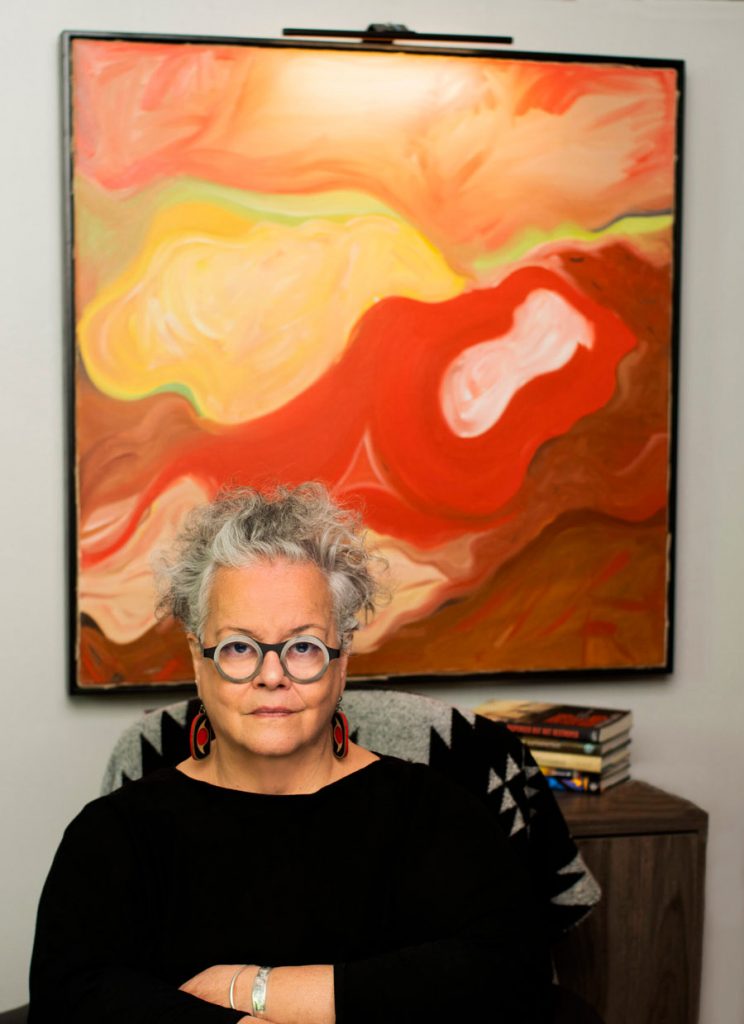
Wyandot FaithKeeper – Crawford Lake is an Ancestral home for Wyandot Elder, FaithKeeper, and artist Catherine Tàmmaro. She was involved in the ceremony prior to extracting the now-famous sediment layers from Crawford Lake, and is the creator of a range of art that has been displayed at the lake including a beaded interpretation of the layers of sediment. Submitted photo
Tàmmaro said the news of a potential new epoch should be a call to action for people to renew their relationship with nature.
She has “deep-seated grief about the fact that Mother Earth has registered these difficult events environmentally and spiritually.”
In her view, “the consciousness of the Earth manifests itself in bodies of water, people and animals.”
Human arrogance has led us to this state of the world, Tàmmaro said.
She considers everything in the natural world our kin, and said “if we could restore right relations with our relatives, then we’d be in a much better place.”
Scientists, conservationists and Indigenous people worked together to restore right relations with the lake when extracting the samples that hold the evidence of the Great Acceleration.
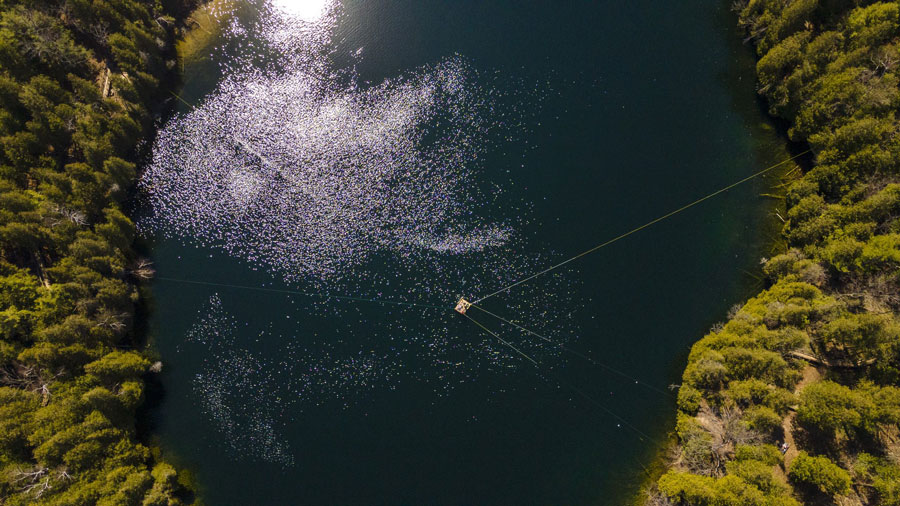
‘Endowed with Spirit’ – Before scientists went out into the lake to extract the samples that have been selected to mark the possible Anthropocene, ceremony was shared to respect the lake. Wyandat Elder and FaithKeeper Catherine Tàmmaro said “the lake is filled with spirit.” Submitted photo
Consent and ceremony
Before extraction, Conservation Halton consulted Indigenous partners to ensure they respected and honoured the lake throughout the process, Bartley said.
Tàmmaro said Indigenous people gathered at the lake to “discuss whether or not we were comfortable with the scientists going ahead. Because many of us weren’t.”
The Indigenous advisors eventually gave consent because of the “importance of this information gathering,” she said. “None of us were pleased about it, but we knew it had to be done.”
Tàmmaro compared the extraction to an “exploratory surgery where you have to go in to find out what you need for the survival of the whole being.
“The definition of a geological epoch is critical information,” she said.
After consent was given, ceremony was shared.
“It was a moment of gathering together as people, no matter what our traditions were, to honour this body of water and all it is prepared to give to help us,” including the many ways lakes support people in addition to the scientific contribution.
Water “is medicine,” Tàmmaro said.
The ceremony was an opportunity for scientists to learn about the personhood of the lake, she said. It was also a process that “helped the lake to understand what was happening.
“I did address the lake directly to offer my condolences, and also my appreciation for their cooperation,” Tàmmaro added.
The successful extraction shows the lake consented, Tàmmaro said. If they had not been able to extract the sample, that would show the lake did not consent and the scientists would have to move on.
“We were very thankful to the lake for allowing the scientists to proceed with what needed to happen,” she added.
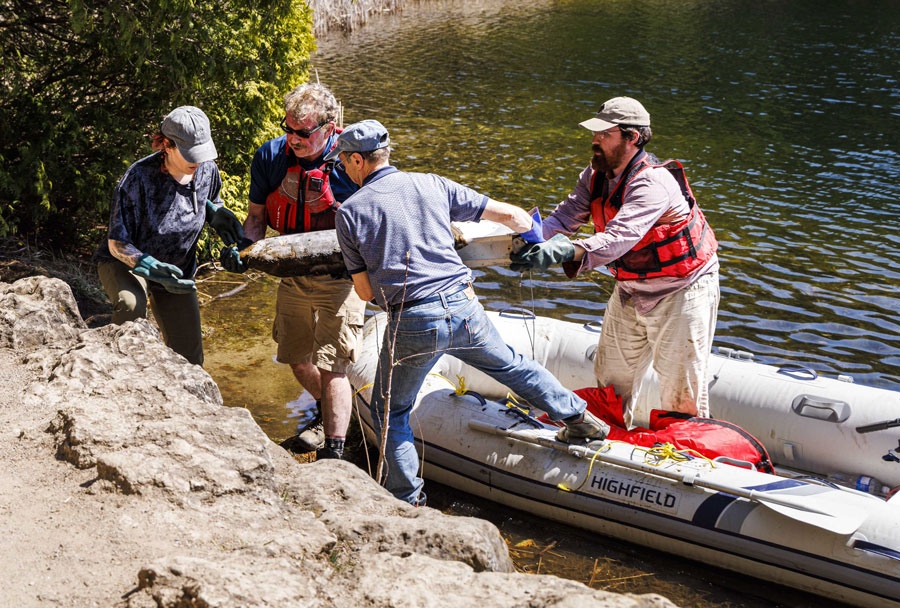
The now-famous sample – Researchers carry the sample pulled from the bottom of Crawford Lake to the research area. From left: then-Carleton undergraduate student Krysten Lafond, Carleton University Professor of Earth Sciences Tim Patterson, Canadian Museum of Nature senior research assistant Paul Hamilton, and Maxim Ralchenko from Carleton University. Submitted photo
Two-eyed seeing
Crawford Lake shows an example of two-eyed seeing, Tàmmaro said, a phrase developed by Mi’kmaq Elder Albert Marshall. It refers to how science and Indigenous thinking support one another.
“Not that science validates Indigenous thinking, but that scientists are realizing Indigenous Peoples have much deeper insights into nature than they thought they did,” she said.
One of Tàmmaro’s art pieces beadSpitter, is a beaded interpretation of the sedimentary layers under the lake, showcasing the “science of an Indigenous piece of artwork.”.
The art is an “agreement with the lake to protect it,” Tàmmaro said.
More information about the geological significance of Crawford Lake is available at www.conservationhalton.ca/crawford-lake-studies.
To learn more in person, Bartley recommends people visit while educators are available, between 10am and 4pm.
The educators are “excited to talk all things Anthropocene,” she said, and “are trained to talk about this in a way that is accessible.” Visits can be booked online at www.parkvisit.ca.
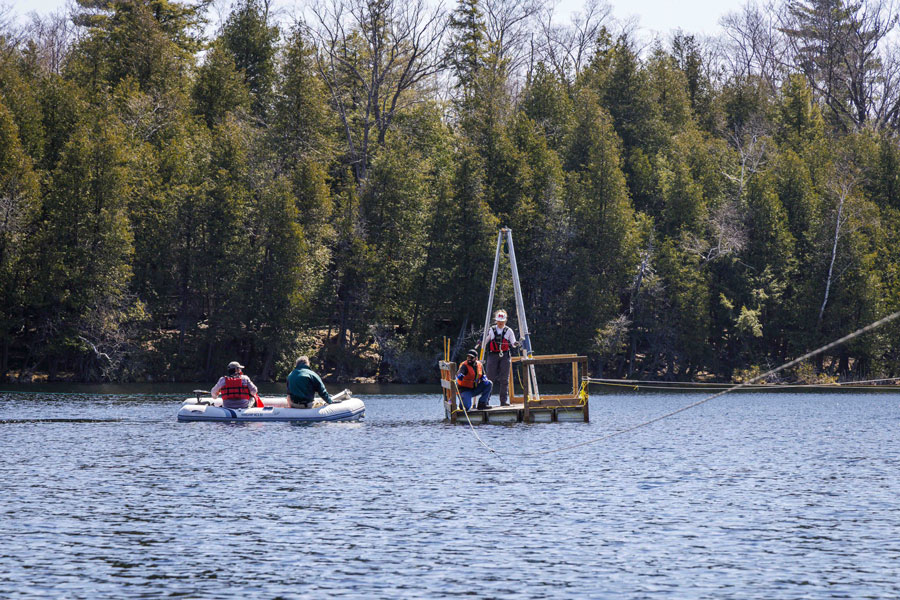
Extraction – A team of scientists removed a core sample from the sediment deep under Crawford Lake. Layers in this sediment paint a picture of humanity’s impact upon the earth, with traces of Plutonium from atomic bomb testing and fly ash from fossil fuels. Submitted photo.




